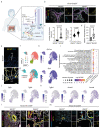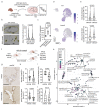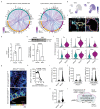A TGFβ-ECM-integrin signaling axis drives structural reconfiguration of the bile duct to promote polycystic liver disease
- PMID: 37703354
- PMCID: PMC7615241
- DOI: 10.1126/scitranslmed.abq5930
A TGFβ-ECM-integrin signaling axis drives structural reconfiguration of the bile duct to promote polycystic liver disease
Abstract
The formation of multiple cysts in the liver occurs in a number of isolated monogenic diseases or multisystemic syndromes, during which bile ducts develop into fluid-filled biliary cysts. For patients with polycystic liver disease (PCLD), nonsurgical treatments are limited, and managing life-long abdominal swelling, pain, and increasing risk of cyst rupture and infection is common. We demonstrate here that loss of the primary cilium on postnatal biliary epithelial cells (via the deletion of the cilia gene Wdr35) drives ongoing pathological remodeling of the biliary tree, resulting in progressive cyst formation and growth. The development of cystic tissue requires the activation of transforming growth factor-β (TGFβ) signaling, which promotes the expression of a procystic, fibronectin-rich extracellular matrix and which itself is perceived by a changing profile of integrin receptors on the cystic epithelium. This signaling axis is conserved in liver cysts from patients with either autosomal dominant polycystic kidney disease or autosomal dominant polycystic liver disease, indicating that there are common cellular mechanisms for liver cyst growth regardless of the underlying genetic cause. Cyst number and size can be reduced by inhibiting TGFβ signaling or integrin signaling in vivo. We suggest that our findings represent a therapeutic route for patients with polycystic liver disease, most of whom would not be amenable to surgery.
Conflict of interest statement
Figures




References
Publication types
MeSH terms
Substances
Supplementary concepts
Associated data
Grants and funding
LinkOut - more resources
Full Text Sources

